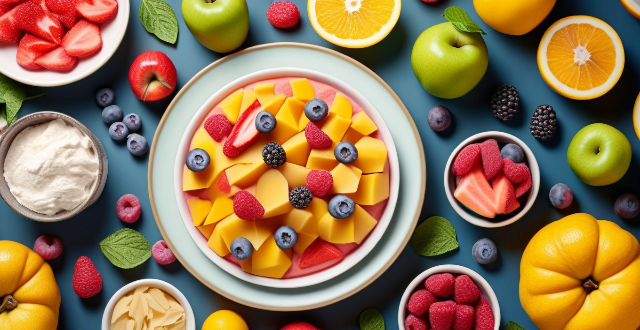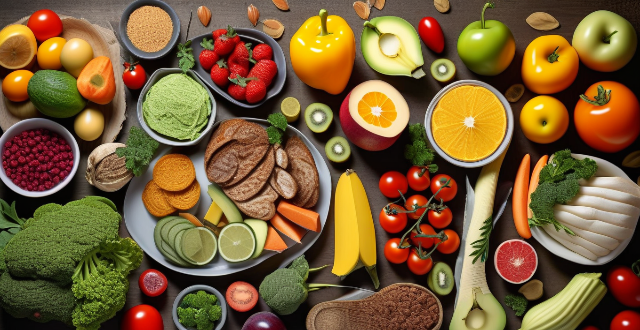Eat Fruit

What are some creative ways to incorporate fruit into my breakfast ?
Incorporating fruits into your breakfast can add flavor, color, and nutrition to your morning meal. Here are some creative ideas: smoothie bowls with frozen fruits and topped with fresh fruits, nuts, seeds, and superfoods; fruit salad with a light honey-lime dressing served on its own or over leafy greens; pancakes and waffles mixed with mashed bananas or pureed berries and topped with fruit compote; oatmeal stirred in with diced apples, pears, or pomegranate seeds and drizzled with honey and cinnamon; toast toppings like cream cheese or peanut butter with sliced bananas or avocado slices sprinkled with hemp seeds; egg dishes like an egg white omelet filled with sautéed apples and cinnamon or a frittata made from diced tomatoes and bell peppers mixed with beaten eggs; and cereals and yogurt mixed with chopped fruits like blueberries or raspberries for a protein-packed breakfast.

How does a traditional tarte Tatin differ from other fruit tarts ?
Tarte Tatin is a classic French dessert that differs from other fruit tarts in several ways. It is prepared by cooking the fruits first, which releases their natural juices and creates a rich, syrupy filling. The tart is then baked upside down, resulting in a beautiful presentation with caramelized fruits on top and a flaky crust on the bottom. The flavor profile of Tarte Tatin is also unique, with deep, complex flavors created by the caramelization process and a buttery crust that absorbs some of the fruit flavors. Finally, the texture of Tarte Tatin is delicate and moist, with a flaky crust and juicy fruits that create a satisfying contrast. Overall, Tarte Tatin stands out as a delicious and visually stunning dessert that is sure to delight anyone who tries it.

How do I incorporate more fruits and vegetables into my daily meals ?
Incorporating more fruits and vegetables into daily meals is crucial for a balanced diet, providing essential nutrients. To achieve this, start the day with fruit smoothies or salads, snack on vegetable sticks or fruit parings, include veggies in lunch and dinner through salads, stir-fries, and soups, and enjoy fruit-based desserts or healthy cookies. Plan ahead, prep fruits and vegetables in advance, and cook in bulk to simplify the process.

What are the best foods to eat before a workout
The best foods to eat before a workout are those that provide sustained energy and help you feel full without being too heavy. Some options include whole-grain toast with almond butter and banana slices, Greek yogurt with berries and nuts, quinoa bowl with veggies and chicken, oatmeal with fruit and nuts, and protein bar or shake. It's important to avoid foods that are high in fat or fiber before exercising, as they can cause discomfort or slow down digestion. Staying hydrated by drinking plenty of water before, during, and after your workout is also crucial.

What are some quick and easy breakfast recipes for busy mornings ?
Quick and easy breakfast recipes for busy mornings include overnight oats, smoothie bowls, and avocado toast. Overnight oats are made by mixing rolled oats with milk or yogurt and toppings like nuts and dried fruit, then refrigerating overnight. Smoothie bowls are made by blending fruits and vegetables with liquids, then topping with nuts or granola. Avocado toast is made by mashing ripe avocado onto toasted bread and seasoning with salt and pepper.

How long should I wait before eating after a workout
The amount of time one should wait to eat after a workout depends on individual needs and goals. It's important to replenish nutrients lost during exercise, especially after strenuous workouts, by eating a meal or snack within 30 minutes to an hour post-exercise. This aids muscle recovery and provides energy for future workouts. Rehydration is also crucial, with water or sports drinks replacing fluids lost through sweat. Listening to your body's cues is key; if you feel lightheaded or unusually fatigued, it might be a sign to eat sooner. Aim for a balanced meal or snack containing carbohydrates, protein, and healthy fats for muscle repair and sustained energy. The "anabolic window," where muscles are most receptive to nutrients, is often cited as 30-45 minutes after exercise, but recent research suggests this window may be more flexible. Avoid heavy meals immediately after vigorous workouts; start with lighter options like smoothies or yogurt with fruit. Timing and personal goals should also be considered; weight loss seekers might opt to wait longer to eat, while muscle builders should prioritize protein and carbs sooner. Ultimately, what works best varies from person to person, so it's essential to listen to your body and adjust accordingly.